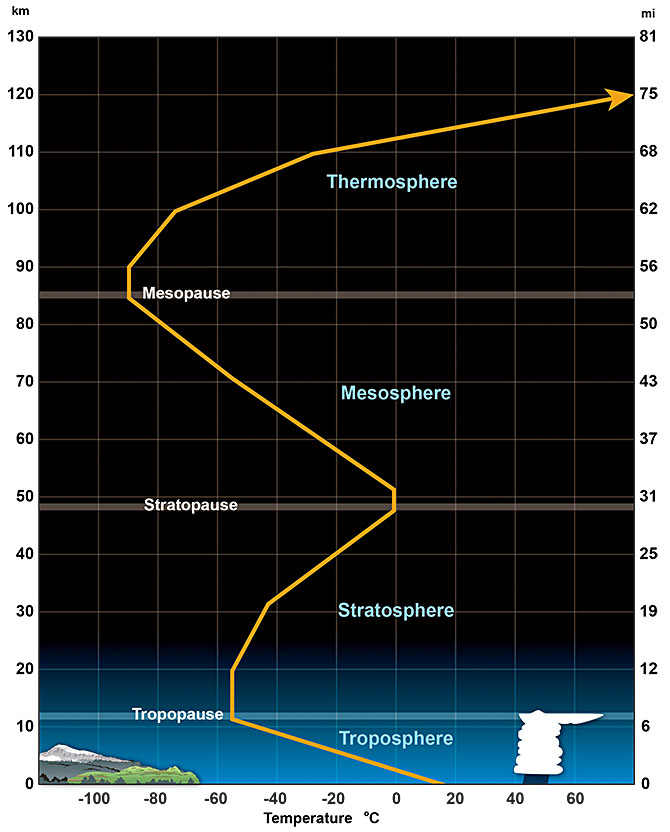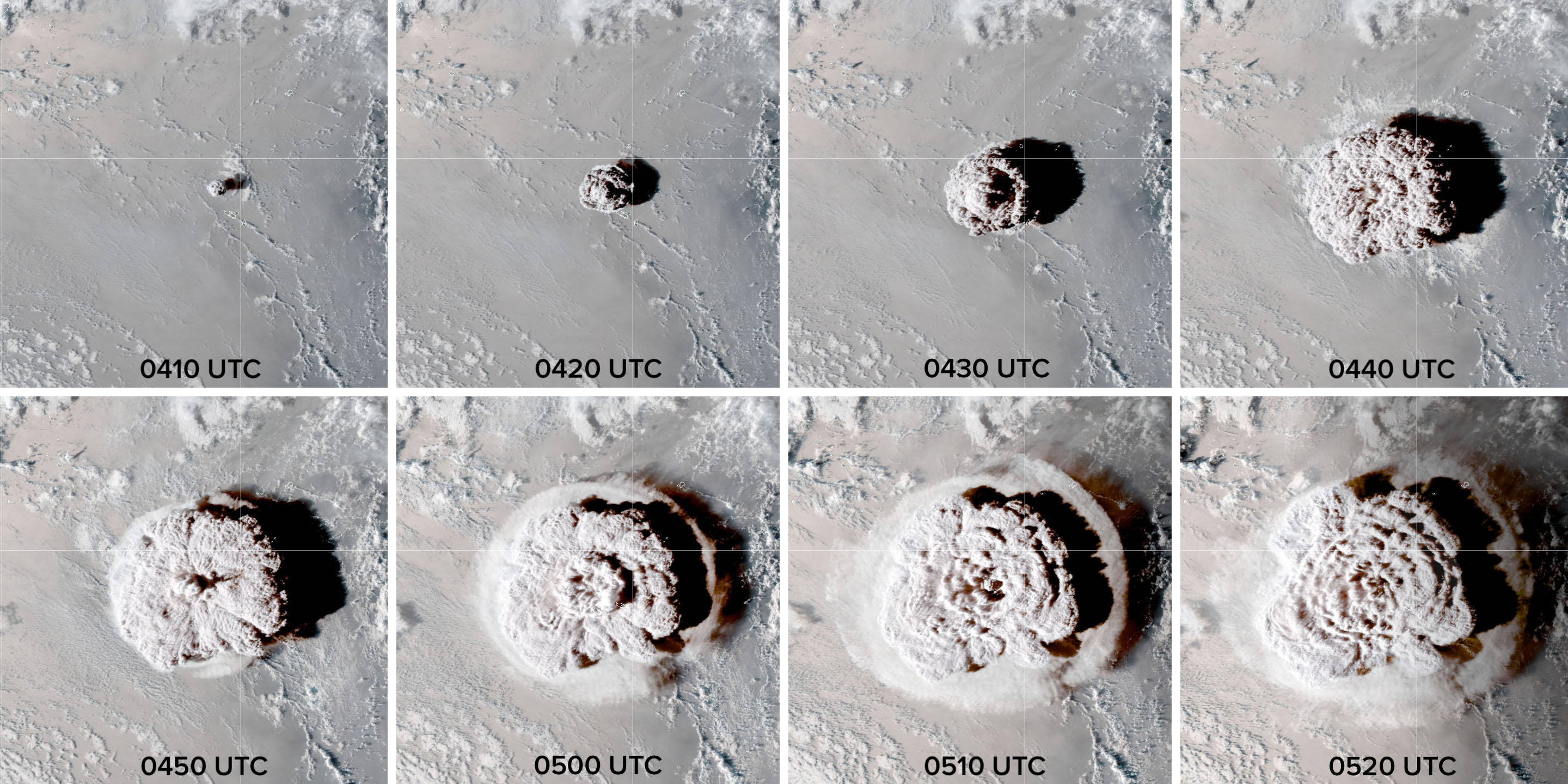Hunga Tonga-Hunga Ha'apai plume penetrated the mesosphere
NASA scientists have revealed that the plume from last month’s Hunga Tonga – Hunga Ha’apai volcanic eruption rocketed 58 kilometers into the atmosphere, allowing it to briefly penetrate the mesosphere.
Layers of our atmosphere
Our planet’s atmosphere is made up five main layers. From the ground up, these layers are called the:
- Troposphere
- Stratosphere
- Mesosphere
- Thermosphere
- Exosphere

Image: Typical temperature profile of the lowest four layers of Earth's atmosphere. Source: NOAA
Most of the weather we see and feel occurs inside the troposphere, which rises from the surface to an altitude of about 10km above sea level. Temperature typically gets cooler with height in the troposphere, which creates the buoyancy needed for thunderstorm development. Most of our atmosphere’s water vapour also lives in the troposphere, which is why clouds can easily develop within this layer.
The next layer up is the stratosphere, which rises from the top of the troposphere to about 50km above sea level. This layer contains a lot of the atmosphere’s ozone, which helps shield our planet’s surface from dangerous UV radiation emitted by the Sun. Passenger aeroplanes usually fly near the bottom of the stratosphere. Unlike the troposphere, temperature gets warmer with height in the stratosphere, which makes it a stable layer of the atmosphere that is hard for rising clouds to penetrate.
Above the stratosphere lies the mesosphere. This is a very dry layer of the atmosphere that rises from the top of the stratosphere to around 80-90km above sea level. Like the troposphere, temperatures cool with height in the mesosphere, but because the air is so dry, it is extremely difficult for clouds to form here.
The thermosphere and exosphere are the next two layers up, rising from the top of the mesosphere to the edge of space, with the air gradually getting thinner with height.
Tonga’s towering volcanic plume
Normal thunderstorm clouds that develop in the troposphere struggle to penetrate the stratosphere. This is because hot air rises when cooler air sits above it, and the air in the stratosphere gets warmer with height. It is common to see the top of thunderstorm clouds hit the base of the stratosphere and spread out horizontally in an anvil-like shape.
However, when the uplift is strong enough, clouds can be forced up through the stratosphere and this has been known to occur above volcanoes.
Last month’s eruption of the Hunga Tonga – Hunga Ha’apai volcano in Tonga sent a plume of ash, gas and steam high into the atmosphere. It was so powerful that the plume ripped straight through the stratosphere and briefly penetrated the mesosphere.
NASA scientists analysed data from two separate satellites to measure how high the plume reached. According to their findings, the Hunga Tonga – Hunga Ha’apai volcano plume rose to an elevation of about 58 km, which can be seen in the video below.
Video: False-colour infrared satellite images of the Hunga Tonga – Hunga Ha’apai volcano eruption on January 15, 2022, created by combining imagery from the HImawari-8 and GEOS-17 satellites. Source: NASA
The 58-kilometre peak plume height from the Hunga Tonga – Hunga Ha’apai volcano is the tallest volcanic plume ever recorded in the satellite era, beating the previous record of 35 km from Mount Pinatubo in the Philippines in 1991.
The images below show the progress of the eruption over a 70-minute period on January 15, with the top of the plume reaching the mesosphere in the third frame at 0430 UTC. The peak of the plume can then be seen collapsing in the fourth frame (0440 UTC), as the rest of the plume starts to spread out in the stratosphere.

Image: GOES-17 satellite images if the Hunga Tonga – Hunga Ha’apai volcanic eruption on January 15, 2022. Source: NASA
Being an underwater volcano, the plume that rose above Hunga Tonga – Hunga Ha’apai on January 15 carried huge amounts of steam with it. This airborne moisture helped create an immense amount of lighting, with Vaisala reporting more than 400,000 lightning strikes within a six-hour window following the eruption. Impressively, nearly 60 percent of these lightning strikes were cloud-to-ground strikes, which is well above the 10-20 percent of cloud-to-ground strikes we see with typical thunderstorms.
The gas and ash that was ejected into the stratosphere and mesosphere last month is now circulating our planet in strong upper-level winds. This has been creating some colorful sunrises and sunsets over the past month, even as recently as this week in Australia.
Ash from the volcanic eruption in Tonga one month ago is, apparently, drifting over Australia for a second time (westward, in the stratosphere). pic.twitter.com/ZZQAOuPXVW
— Andrew Miskelly (@andrewmiskelly) February 14, 2022
According to NASA, the aerosols from the Hunga Tonga – Hunga Ha’apai plume may stay in the stratosphere for more than a year.